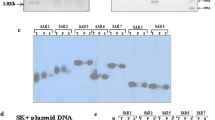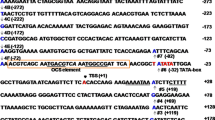Abstract
A 395 bp fragment located downstream from the soybean heat shock geneGmhsp 17.6-L exhibits several characteristics of scaffold attachment region (SAR) sequences. It contains matrix consensus elements, a topoisomerase II binding sequence and it associates with the isolated nuclear scaffold of soybeanin vitro. Chimaeric genes containing the SARL fragment either at one side (5′ or 3′) or at both sides of a heat shock promoter-regulated β-glucuronidase reporter gene were constructed. A five-to nine-fold increase of heat-inducible β-glucuronidase activity was observed in transgenic tobacco plants containing constructs with SARL fragments either at both sides or with at least one SARL copy located upstream from the reporter gene. The gene copy number is positively correlated with the level of heat-inducible reporter gene activity in these. plants but positional effects are not entirely eliminated. Thus, SAR sequences may potentially be used to increase gene expression, via as yet unknown mechanisms, and to reduce adverse effects on the expression of multiple gene copies in transgenic plants.
Similar content being viewed by others
References
Baumann, G., Raschke, E., Bevan, M. and Schöffl, F. (1987) Functional analysis of sequences required for transcriptional activation of a soybean heat shock gene in transgenic tobacco.EMBO J. 6, 1161–6.
Bäumlein, H., Müller, A.J., Schiemann, J., Helbing, D., Manteuffel, R. and Wobus, U. (1988) Expression of aVicia faba legumin B gene in transgenic tobacco plants: gene dosage-dependent protein accumulation.Biochem. Physiol. Pflanzen 183, 205–10.
Bäumlein, H., Boerjan, W., Nagy, I., Panitz, R., Inze, D. and Wobus, U. (1991) Upstream sequences regulating legumin gene expression in heterologous transgenic plants.Mol. Gen. Genet. 225, 121–8.
Bode, J. and Maass, K. (1988) Chromatin domain surrounding the human interferon-β gene as defined by scaffold-attachment regions.Biochem. 27, 4706–11.
Bray, E.A., Naito, S., Pan, N-S., Anderson, E., Dube, P. and Beachy, R.N. (1987) Expression of the β-subunit of β-conglycinin in seeds of transgenic plants.Planta 172, 364–70.
Breyne, P., Van Montagu, M., Depicker, A. and Gheysen, G. (1992) Characterization of a plant scaffold attachment region in a DNA fragment that normalizes transgene expression in tobacco.Pl. Cell. 4, 463–71.
Chen, Z-L., Naito, S., Nakamura, I. and Beachy, R.N. (1989) Regulated expression of genes encoding soybean β-conglycinin in transgenic plants.Dev. Genet. 10, 112–22.
Cockerill, P.N. and Garrard, W.T. (1986) Chromosomal loop anchorage of the kappa immunoglobulin gene occurs next to the enhancer in a region containing topoisomerase II sites.Cell 44, 273–82.
Czarnecka, E., Key, J.L. and Gurley, W.B. (1989) Regulatory domains ofGmhsp 17.5-L heat shock promoter of soybean.Mol. Cell. Biol. 9, 3457–63.
Gasser, S.M. and Laemmli, U.K. (1987) A glimpse at chromosomal order.Trends Genet. 3, 16–22.
Gasser, S.M. and Laemmli, U.K. (1986) Cohabitation of scaffold binding regions with upstream/enhancer elements of three developmentally regulated genes ofD. melanogaster.Cell 46, 521–30.
Hall, G. Jr., Allen, G.C., Loer, D.S., Thompson, W.F. and Spiker, S. (1991) Nuclear scaffolds and scaffold-attachment regions in higher plants.Proc. Natl Acad. Sci. USA 88, 9320–4.
Horsch, R.B., Fraley, R.T., Rogers, S.G., Sanders, P.R., Lloyd, A. and Hoffmann, N. (1984) Inheritance of functional foreign genes in plants.Science 223, 496–8.
Horsch, R.B., Fry, J.E., Hoffmann, N.L., Eichholtz, D., Rogers, S.G. and Fraley, R.T. (1985) A simple and general method for transferring genes into plants.Science 227, 1229–31.
Jackson, D.A. (1986) Organization beyonnd the gene.Trends Biol. Sci. 6, 294–52.
Jackson, D.A., Yuan, J. and Cook, P.R. (1988) A gentle method for preparing cyto- and nucleo-skeletons and associated chromatin.J. Cell Sci. 90, 365–78.
Jefferson, R.A. (1987) Assaying chimeric genes in plants: the GUS gene fusion system.Pl. Mol. Biol. Rep. 5, 387–405.
Jorgenson, R. (1990) Altered gene expression in plants due totrans interactions between homologous genes.Trends Biotech. 8, 340–4.
Klehr, D., Maass, K. and Bode, J. (1991) Scaffold-attached regions from the human interferon β domain can be used to enhance the stable expression of genes under the control of various promoters.Biochem. 30, 1264–70.
Krol, A.R. van der, Mur, L.A., Beld, M., Mol, J.M.M. and Stuitje, A.R. (1990) Flavonoid genes inPetunia: addition of a limited number of gene copies may lead to a suppression of gene expression.Pl. Cell 2, 291–9.
Laemmli, U.K., Käs, E., Poljak, L. and Adachi, Y. (1992) Scaffold-associated regions:cis-acting determinants of chromatin structural loops and functional domains.Curr. Opin. Gent. Dev. 2, 275–85.
Linn, F., Heidmann, I., Saedler, H. and Meyer, P. (1990) Epigenetic changes in the expression of the maizeA1 gene inPetunia hybrida: role of numbers of integrated gene copies and state of methylation.Mol. Gen. Genet. 222, 329–36.
Mann, H.D. and Whitney, D.R. (1947) On a test of whether one of two random variables is stochastically larger than the other.Ann. Math. Statist. 18, 50.
Matzke, M.A. and Matzke, A.J.M. (1989) Gene interactions and epigenetic variation in transgenic plants.Dev. Genet. 11, 214–23.
Matzke, M.A., Priming, M., Trnovsky, J.and Matzke, A.J.M. (1989) Reversible methylation and inactivation of marker genes in sequentially transformed tobacco plants.EMBO J. 8, 643–9.
Mielke, C., Kohwi, Y., Kohwi-Shigematsu, T., Bode, J. (1990) Hierarchical binding of DNA fragments derived from scaffold-attachment regions: correlation of propertiesin vitro and functionin vivo.Biochem. 29, 7475–7485.
Mirkovitch, J., Mirault, M.E. and Laemmli, U.K. (1984) Organization of the higher order chromatin loop: specific DNA attachment sites on nuclear scaffold.Cell 39, 223–32.
Morimoto, R.I., Tissieres, A. and Georgopoulos, C. (eds) (1990)Stress Proteins in Biology and Medicine. Cold Spring Harbor, NY: Cold Spring Harbor Laboratory Press.
Napoli, C., Lemieux, C. and Jorgensen, R. (1990) Introduction of a chimaeric chalcone synthase gene into petunia results in reversible co-suppression of homologous genesin trans.Pl. Cell 2, 279–89.
Neumann, D., Nover, L., Parthier, B., Rieger, R., Scharf, K.-D., Wohlgiehn, R. and zur Nieden, U. (1989) Heat shock and other stress response systems of plants.Biol. Zentralblatt 108, 1–156.
Newbigin, E.J., deLumen, B.O., Chandler, P.M., Gould, A., Blagrove, R.J., March, J.F., Kortt, A.A. and Higgins, T.J.V. (1990) Pea convicilin: structure and primary sequence of the protein and expression of a gene in the seeds of transgenic tobacco.Planta 180, 461–70.
Phi-Van, L., von Kries, J.P., Ostertag, W. and Stätling, W.H. (1990) The chicken lysozyme 5′ matrix attachment region increases transcription from a heterologous promoter in heterologous cells and dampens position effects on the expression of transfected genes.Mol. Cell. Biol. 10, 2302–7.
Raschke E., Baumann, G. and Schöffl, F. (1988) Nucleotide sequence analysis of soyabean small heat shock protein genes belonging to two different multigene families.J. Mol. Biol. 199, 549–57.
Rieping, M. and Schöffl, F. (1992) Synergistic effect of upstream sequences, CCAAT box elements, and HSE sequences for enhanced expression of chimaeric heat shock genes in transgenic tobacco.Mol. Gen. Genet. 231, 226–32.
Rivier, D.H. and Rine, J. (1992) Silencing: the establishment and inheritance of stable, repressed transcription states.Curr. Opin. Genet. Dev. 2, 286–92.
Sambrook, J., Fritsch, E.F. and Maniatis, T. (1989)Molecular Cloning: a Laboratory Manual (2nd edition). Cold Spring Harbor, NY: Cold Spring Harbor Laboratory Press.
Schöffl, F. (1988) Genetic engineering strategies for manipulation of the heat shock response.Pl. Cell Environ. 11, 339–43.
Schöffl, F. and Baumann, G. (1985) Thermoinduced transcripts of a soyabean heat shock gene after transfer into sunflower using a Ti plasmid vector.EMBO J. 4, 1119–24.
Schöffl, F., Rossol, I., and Angermüller, S. (1987) Regulation of the transcription of heat shock genes in nuclei from soybean (Glycine max) seedlings.Pl. Cell. Environm. 10, 113–9.
Schöffl, F., Rieping, M., Baumann, G., Bevan, M.W. and Angermüller, S. (1989) The function of plant heat shock promoter elements in the regulated expression of chimaeric genes in transgenic tobacco.Mol. Gen. Genet. 217, 246–53.
Schöffl, F., Rieping, M. and Raschke, E. (1990) Functional analysis of sequences regulating the expression of heat shock genes in transgenic plants. In Lycett, G.W. and Grierson, D., eds.,Genetic Engineering of Crop Plants, pp. 79–4. London: Butterworths Ltd.
Schöffl, F., Rieping, M. and Severin, K. (1991) The induction of the heat shock response: activation and expression of chimaeric heat shock genes in transgenic plants. In Herrmann, R. ed.,Plant Molecular Biology2, pp. 685–694. New York: Plenum Publishing Corporation.
Schöffl, F., Diedring, V., Kliem, M., Rieping, M., Schröder, G. and Severin, K. (1992) The heat shock response in transgenic plants: the use of chimaeric heat shock genes. In Wray, J.L., ed.,Inducible Plant Proteins: Their Biochemistry and Molecular Biology. pp. 247–65. Cambridge: Cambridge University Press.
Slatter, R.E., Dupree, P. and Gray, J.C. (1991) A scaffold-associated DNA region is located downstream of the pea plastocyanin gené.Pl. Cell 3, 1239–50.
Stief, A., Winter, D.M., Strätling, W.H. and Sippel, A.E. (1989) A nuclear DNA attachment element mediates elevated and position-independent gene activity.Nature 341, 343–5.
Author information
Authors and Affiliations
Rights and permissions
About this article
Cite this article
Schöffl, F., Schröder, G., Kliem, M. et al. An SAR sequence containing 395 bp DNA fragment mediates enhanced, gene-dosage-correlated expression of a chimaeric heat shock gene in transgenic tobacco plants. Transgenic Research 2, 93–100 (1993). https://doi.org/10.1007/BF01969382
Received:
Revised:
Accepted:
Issue Date:
DOI: https://doi.org/10.1007/BF01969382




